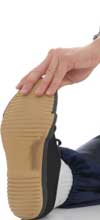|
Home / Exercising / Fitness tests / Flexibility tests / Sit & reach tests / Modified sit & reach
Modified Sit & Reach Test
Introduction
Individuals who have trouble with flexibility should be performing a modified sit and reach test rather than the standard version.
This variety is slightly easier than the original and is a great option for seniors or those who are generally less supple or stiff in nature.
|
What is the point?
Your freedom of movement and overall posture can be greatly affected by both your hamstrings and lower back muscles, so measuring their flexibility is very important.
The objective of the modified sit and reach test is still to assess the flexibility of the lower back and hamstrings, however this assessment causes less forward rotation of the pelvis which then helps to reduce the compression that is experienced in the lower back.
What do you need?
- A flat surface
- A measuring tape
- A box
This test can be performed almost anywhere and you won't need a partner either.
How do you do the test?
- Sit facing the box, having removed your shoes
- Place measuring tape away from box, with 0cm at the base of box/table
- One leg should be extended so that the knee is straight and is placed flat against the box while the other knee is bent
- Place the sole of the foot against (or close to) the inner side of the knee
- The hips must face directly towards the box to ensure proper form
- Then extend arms, one hand on top of the other so the fingertips are even and touching
- Reach forward slowly with the fingers and touch as far down the tape measure as possible
|
 |
This is done three times with the longest distance being recorded.
The test should also be performed with both legs so then you can assess if one leg's hamstrongs has better flexibility than the other.
What results you'll get :
Scoring is as follows
|
Poor |
Below Average |
Average |
Above Average |
Excellent |
| Male |
| 4 to 6cm |
7 to 10cm |
11 to 14cm |
14cm + |
| Female |
| 4 to 6cm |
7 to 11cm |
12 to 15cm |
15cm + |
Make sure you also perform some warm-up exercises before doing the assessment as it will make the muscles and ligaments more elastic and help with your score.
What is being measured again?
These tests measure the flexibility and strength of the hamstrings and lower back muscles.
|
|